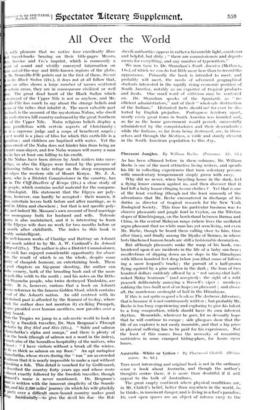All Over
the World
is with pleasure that we notice four excellently illus-
d travel-books 'bearing on their title-pages Messrs. ev, Service and Co.'s imprint, which is commonly a int of sound and vividly conveyed information on in out-of-the-way and little-known regions of the globe. Mr. Doraville-Fife points out in the first of these, Savage in the Black Sudan (21s.), it does not at all follow that, use an atlas shows a large number of names scattered certain areas, they are in consequence civilized or well wn. The great dead heart of the Black Sudan which westward of the Upper Nile is not so anyhow, and Mr. tville-Fife has much to say about the strange beliefs and tans of the tribes that inhabit it. The most valuable part is book is the account of the mysterious Nubas, who dwell be rock-strewn hill country embraced by the great Southern w of the Upper Nile. Nuba religious beliefs display a oils parallelism with certain aspects of Christianity : is a supreme judge and a corps of beneficent angels ; next world is a place of bliss for which this earth-life is a nation ; and children are baptized with water. Yet the pus creed of the Nuba does not hinder him from being an terate man-slayer, and few Nuba women will marry a man
he has at least one killing to his credit.
s the Nubas have been driven by Arab raiders into cave- lings, so also the Elgeyo. were forced by the pressure of hbouring tribes to take refuge on the steep escarpment : edges the western side of Mount Kenya. Mr. J. A. snip, who is a District ComMissioner in the country, has e in The Chff-Dwellers of Kenya (21s.) a close study of people, which contains useful material for the compara- ethnologist. His statement that the Elgeyo are poly- us, however, can hardly be accepted : their women, it rue, entertain lovers both before and after marriage, as is era' in Africa and elsewhere ; but that is not specific poly- y. and indeed Mr. Mas.sam's own account of local marriage \.(s monogamy both for husband and wife. Totemic gamy is also maintained, and it is interesting to learn the Elgeyo wife does no work for two months before or month after childbirth. The index to this book is rably unintelligent.
e well-known works of Claridge and Rattray on Ashanti not much added to by Mr. A. W. Cardinall's In Ashanti Beyond (21s.). The author is also a District Commissioner, as such has enjoyed considerable opportunity for obser- n. the result of which is on the whole, despite some tity of cheapish humour, an entertaining book. There good chapters On big-game shooting, the auttair can vibe scenery, both of the brooding bush and of the more park-like veldt to the north ; and his notes on the little- vi Dagoniba people, who twice destroyed Timbuktu, are able. It is, however, curious that a book on Ashanti es no reference to the famous Golden Stool, which contains soul of the Ashanti nation. An odd contrast with its stained past is afforded by the Kumasi of to-day, where ugh the author does not mention it) ex-King Prempeh, once presided over human sacrifices, now presides over a lary board.
roan the Tropics we jump to a. sub-arctic world to look at k by a Swedish traveller, Dr. Sten Bergman's Through hgllia by Dog Sled and Skis (21s.). " Sable and salmon hamehatka's alpha and omega," and there is plenty of in the book (though of salmon not a word in the index), ranch also of the boundless hospitality of the natives, who toast " I have visitors without a break all the winter. Y lie as thick as salmon on my floor." An apt metaphor mchatka, whose rivers during the " run are so crowded salmon that it is nearly impossible to make a cast without .hooking a fish. This detail is vouched for by Guillemard, described the country forty years ago and whose route almost exactly followed by the Swedish traveller, though esaard's name is never mentioned. Dr. Bergman's wit is written with the innocent simplicity of the Scandi- ,and hi:s.2,200 miles' journey (in which his wife pluckily Part) over a difficult snow-bound country makes good ng.givehis due—the Bol-
shevik authorities appear in rather a favourable light, courteous and helpful, but dirty ; " there are commissioners and depart- ments for every t hing, and any number of typewriters."
We now turn to Dr. Shanahan's South America (Methuen, 14s.), of which we can do but little more here than to record the appearance. Primarily the book is intended to meet, and probably will meet, the needs of advanced geographical students interested in the rapidly rising economic position of South America, notably as an exporter of tropical products and foods. One small word of criticism may be ventured on. Dr. Shanahan speaks of the Spaniards as -. in- ellicient administrators," and of their " wholesale destruction of the Indians." Historical facts should not. for ever be dis- torted by English prejudice. Portuguese territory apart, nearly every great town in South America was founded and, so far as the home government would permit, successfully administered by the conquistadores and their descendants ; while the Indians, so far from being destroyed, are, in them- selves and through the Mestizos, a virile and sturdy element in the South American population to this day.






















































 Previous page
Previous page